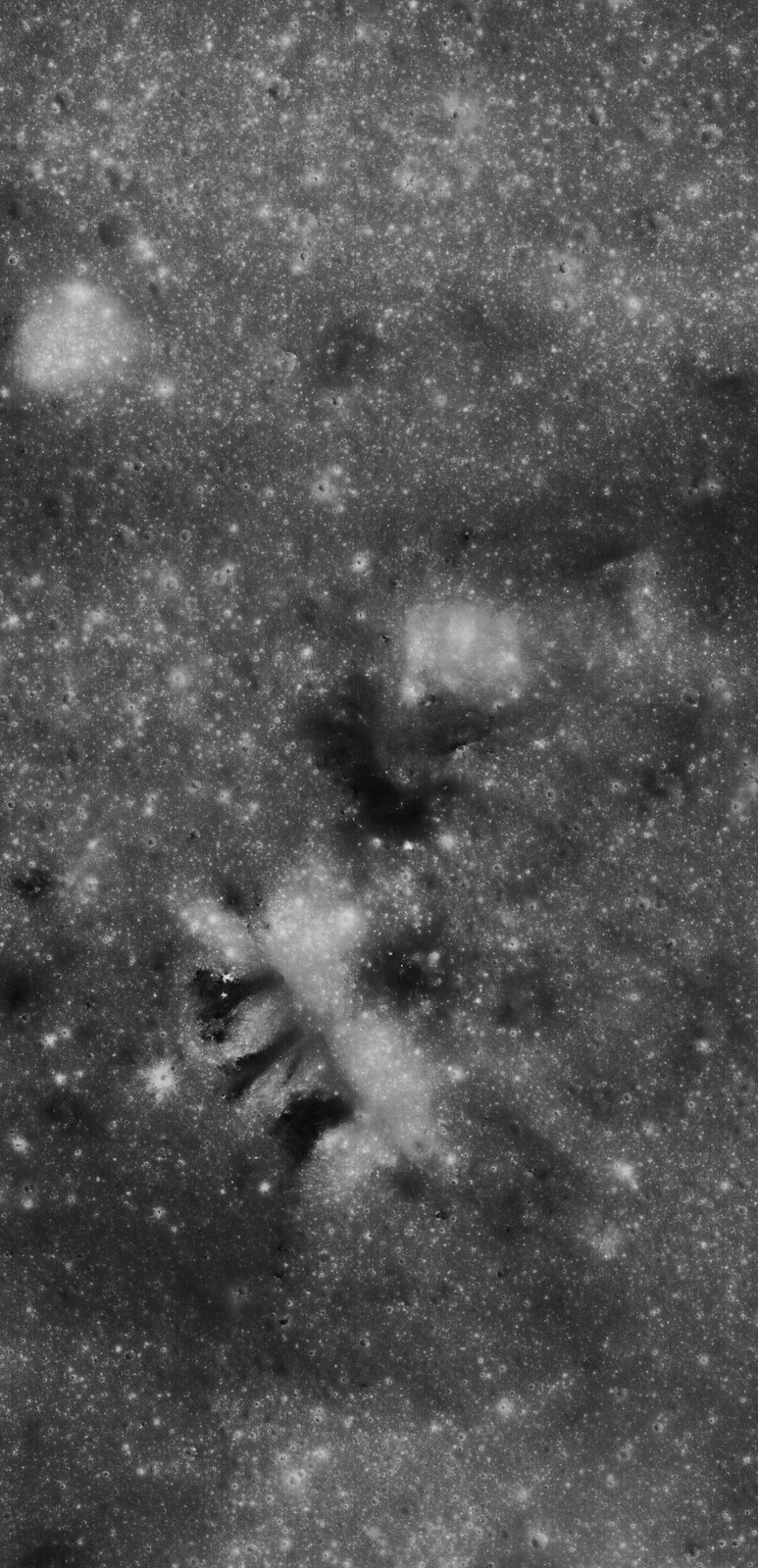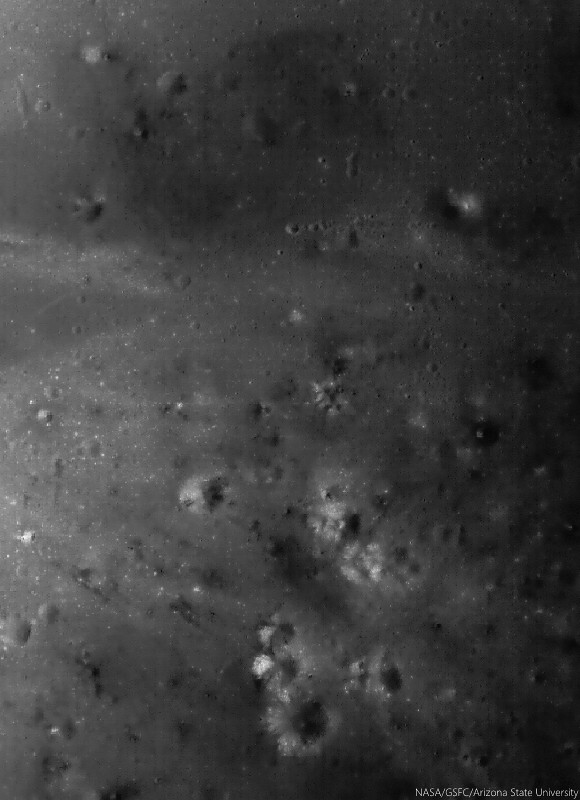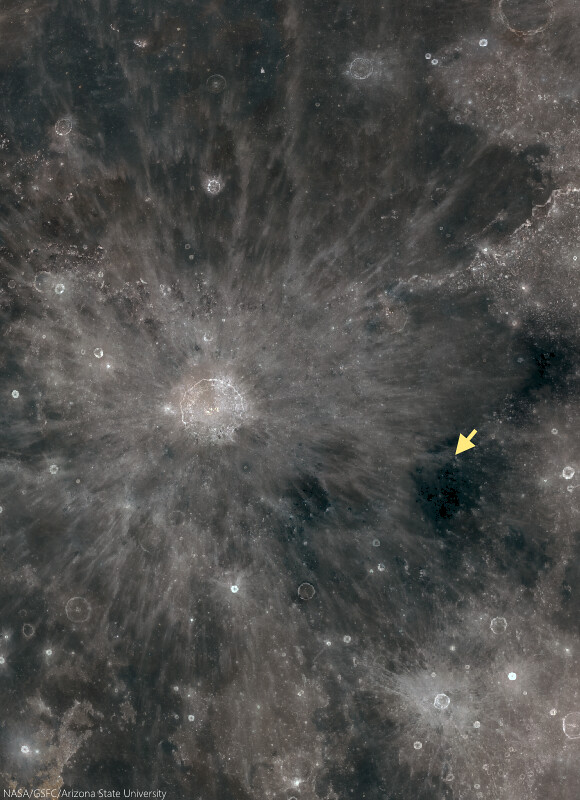 |
| Dark mantle deposits decorate a crater wall. Slowly pulled downhill by gravity, the volcanic glasses that compose these stripes where formed during explosive volcanic eruptions on the Moon. 1130 meter-wide field of view from LROC NAC observation M1101259688L, LRO orbit 14524, September 2, 2012; low incidence 17.83° angle, 97 cm resolution from 117.17 km over 8.26°N 352.18°E [NASA/GSFC/Arizona State University]. |
LROC News System
Today's Featured Image location is in southern Sinus Aestuum.
Low reflectance pyroclastic material flowed downslope (NE) due to mass wasting in this crater, and high reflectance fresh ray material from small young craters dot the streaks.
The high reflectance material from small craters on top of the pyroclastics indicate that the pyroclastic deposit is relatively thin, because the excavated material is from a maximum of about 0.2 crater radii below the surface.
Low reflectance pyroclastic material flowed downslope (NE) due to mass wasting in this crater, and high reflectance fresh ray material from small young craters dot the streaks.
The high reflectance material from small craters on top of the pyroclastics indicate that the pyroclastic deposit is relatively thin, because the excavated material is from a maximum of about 0.2 crater radii below the surface.
 |
| Striped slides of pyroclastic-sourced granular flow, darker material eroding back into its likely source, a "striped crater," a vent north of Schroter T in Sinus Aestuum, east of Copernicus. A 4675 meter-wide-wide field of view from LROC NAC observation M1101259688L, LRO orbit 14524, September 2, 2012; low incidence 17.83° angle, 97 cm resolution from 117.17 km over 8.26°N 352.18°E [NASA/GSFC/Arizona State University]. |
 |
| Schroter T (3.96 km; 7.03°N, 352°E) is the largest of the triplet craters in a "snowman" formation at lower center in this 37 km field of view centered near 7.72°N, 352°E. The energetic creation of Copernicus nearby left its mark on the pyroclastic material, Some high places seem to have been sheered off, leaving dark chevrons pointing away from that direction. LROC Wide Angle Camera (WAC) monochrome (604 nm) observation M160003304CE, LRO orbit 9713, May 14, 2011; 48.97° incidence, 54.53 meters resolution from 38.89 km [NASA/GSFC/Arizona State University]. |
 |
| The striped walls of the pyroclastic vent (arrow, 7.716°N, 352.062°E), in the dark terrains east-southeast of Copernicus, disappear into the long shadows of a complex topography, in the light of sunrise. A roughly 120 km-wide field of view from a distilled LROC WAC mosaic of sequential monochrome (643 nm) observations swept up December 15, 2010; 77° incidence, resolution 63.3 meters from 45 km [NASA/GSFC/Arizona State University]. |
 |
| The small vent in Sinus Aestuum (arrow), 370 km east-southeast of the central peaks of Copernicus, is part of the pyroclastic fields highly visible even in modest binoculars, because of their relative low reflectivity. The area more to the southeast bear Gambart is the site of the Moon's highest concentration of radioactive isotopes, of thorium and less common uranium for example. A roughly 900 km-wide view from the LROC Lunaserv web-mapping program, Test RGB overlay (See "Resolved Hapke Parameter Maps") LROC WAC global mosaic [NASA/GSFC/Arizona State University]. |
Related Posts:


No comments:
Post a Comment